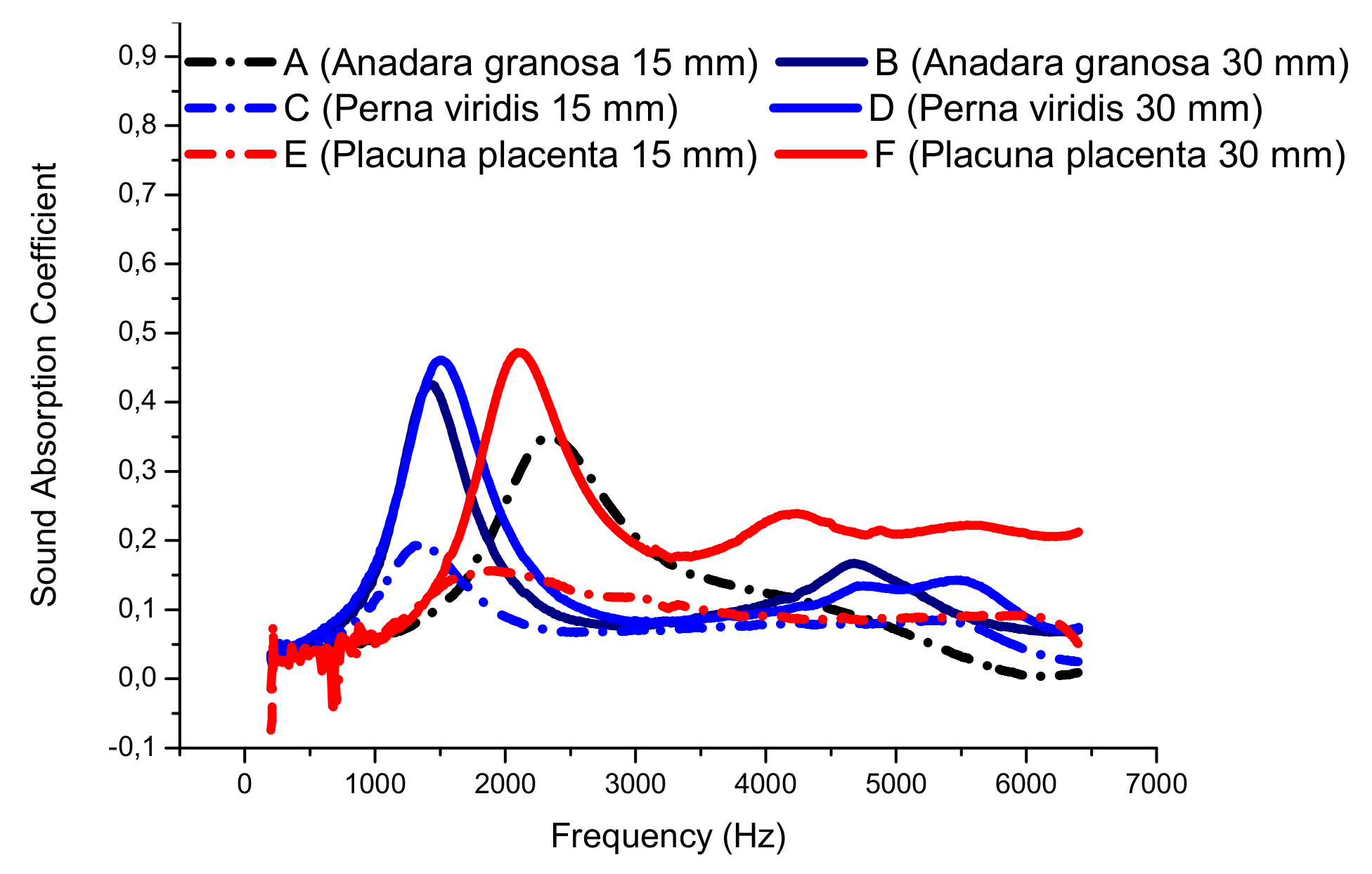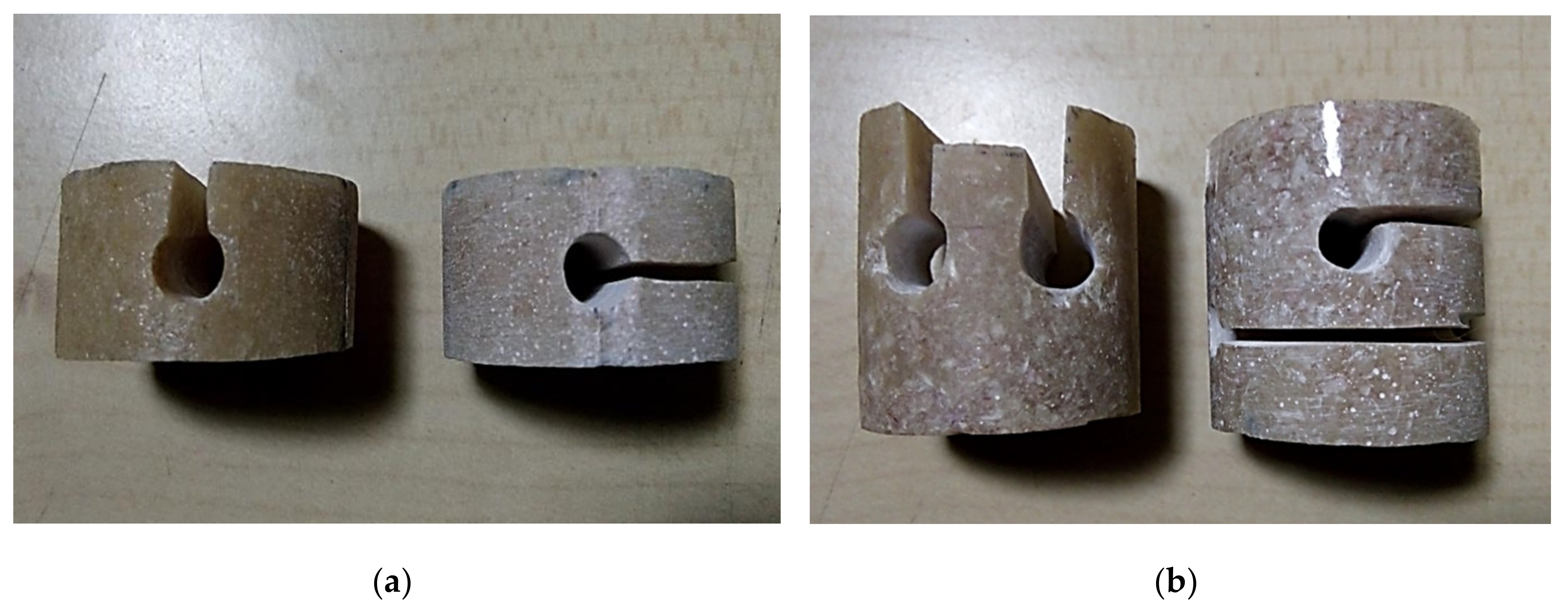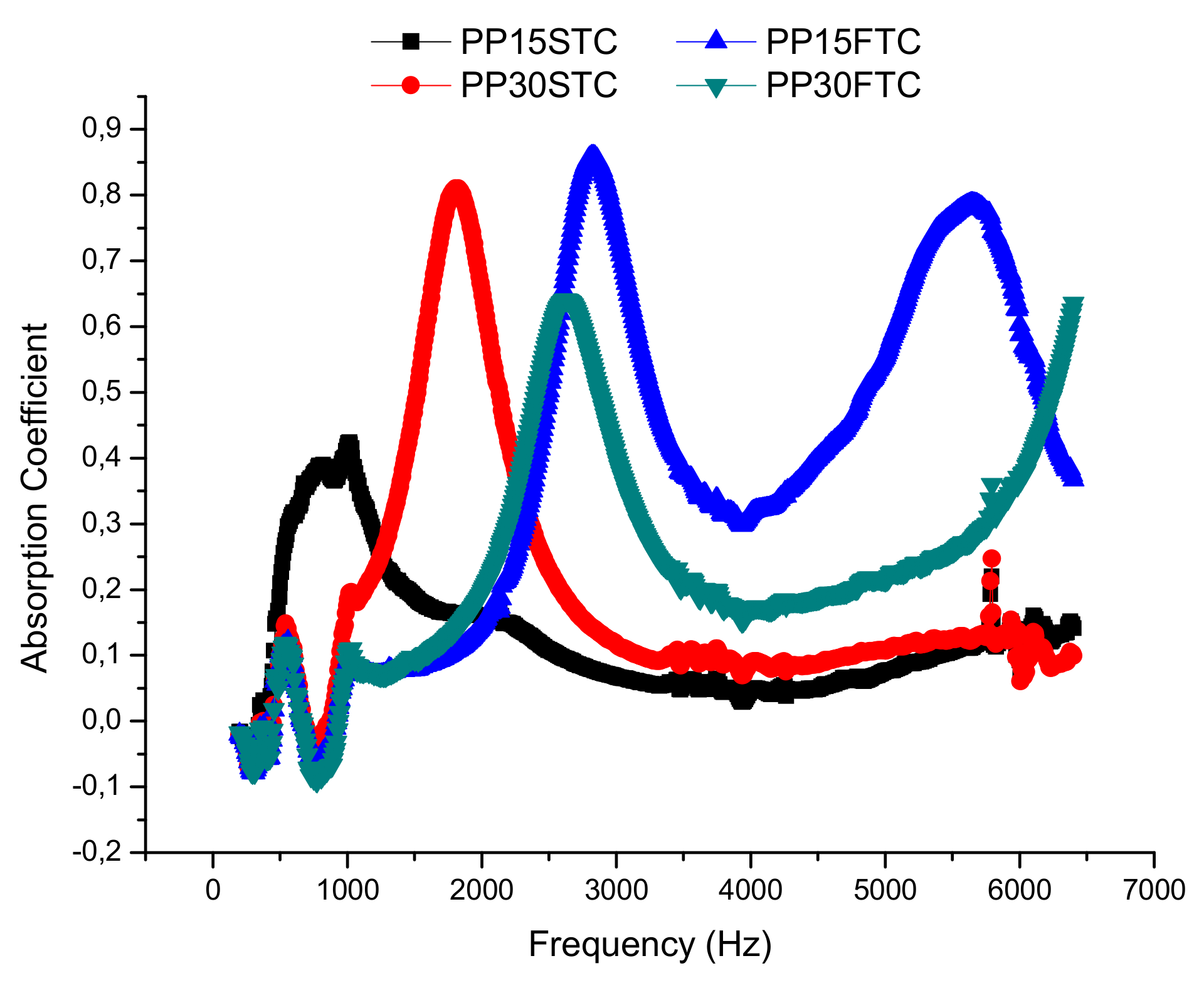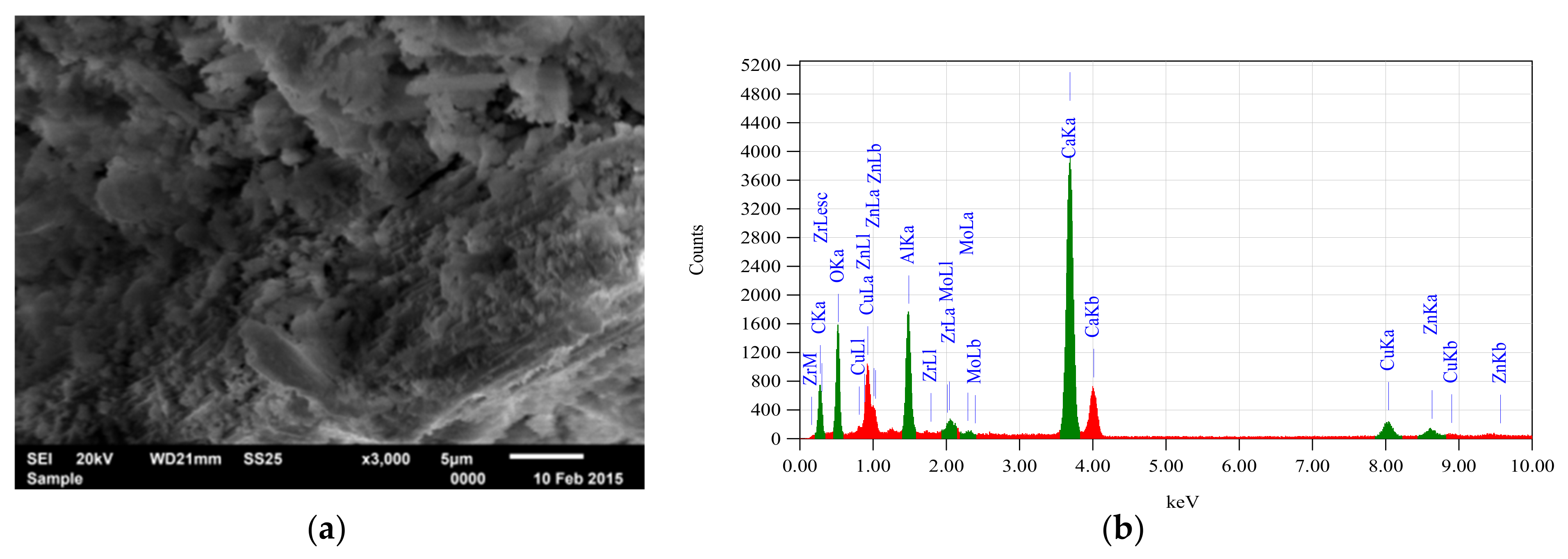On the Role of Acoustical Improvement and Surface Morphology of Seashell Composite Panel for Interior Applications in Buildings
Abstract
1. Introduction
2. Materials and Methods
3. Results and Discussions
3.1. Sound Absorption Coefficient
3.2. Surface Design Treatment of Placuna placenta SFRP on Absorption Performances
3.3. Sound Transmission Loss (STL)
3.4. Simple Surface Morphology
3.5. Oxide Analysis of Seashells
4. Conclusions
Author Contributions
Funding
Acknowledgments
Conflicts of Interest
Nomenclatures
| SFRP | Seashell Fiber Reinforced Polymer |
| ASTM | American Standard Testing and Material |
| FRP | Fiber Reinforced Polymer |
| α | Sound absorption coefficient |
| STL | Sound Transmission Loss |
| MPP | Micro Perforated Panel |
| QRD | Quadratic Residue Diffuser, the type of acoustical components in buildingss |
| B & K | Bruer & Kjaer, manufacture name of the Impedance Tube to measure and observe the acoustical behavior of material |
| STCT | Side-Tailed Cavity Treatment of samples |
| FTCT | Front-Tailed Cavity Treatment of samples |
| HFRC | Hybrid Fibrous Reinforce Composite |
| H | Number of quarter wavelength resonators (4,8) |
| FR | Foam Front Layer |
| Cav | Cavity (10 mm) |
| EDX | Energy Dispersive Spectroscopy (EDS) oxide |
| ZAF | Matrix effect in EDS oxide, related to all elements presents in the sample and in the standard covering Production (Z), Absorption (A) and enhancement of the characteristic radiation (F) that must be taken into account. |
References
- Tronchin, L.; Manfren, M.; Nastasi, B. Energy efficiency, demand side management and energy storage technologies—A critical analysis of possible paths of integration in the built environment. Renew. Sustain. Energy Rev. 2018, 95, 341–353. [Google Scholar] [CrossRef]
- Ellen MacArthur—Foundation, Circularity in the Built Environment: Case Studies a Compilation of Case Studies from the CE100; Ellen MacArthur Foundation: London, UK, 2016.
- Setyowati, E.; Hardiman, G.; Khusnan, P. Green concrete made of oyster shell waste to support green building material. J. Teknol. 2016, 78, 203–207. [Google Scholar]
- Setyowati, E.; Hardiman, G. The Acoustical Performances of Oyster Shell Waste Based Green Concrete Materials. GSTF J. Eng. Technol. 2015, 3, 1–6. [Google Scholar]
- Lee, F.C.; Chen, W. Acoustic Transmission Analysis of Multi-Layer Absorbers. J. Sound Vib. 2001, 248, 621–634. [Google Scholar] [CrossRef]
- Bravo, T.; Maury, C.; Pinhède, C. Absorption and transmission of boundary layer noise through flexible multi-layer micro-perforated structures. J. Sound Vib. 2017, 395, 201–223. [Google Scholar] [CrossRef]
- Takahashi, Y.; Otsuru, T.; Tomiku, R. In situ measurements of surface impedance and absorption coefficients of porous materials using two microphones and ambient noise. Appl. Acoust. 2005, 66, 845–865. [Google Scholar] [CrossRef]
- Odusanya, A.A.; Bolasodun, B.; Madueke, C.I. Property Evaluation of Sea shell Filler Reinforced Unsaturated Polyester Composite. Int. J. Sci. Eng. Res. 2014, 5, 1343–1349. [Google Scholar]
- Fombuena, V.; Bernardi, L.; Fenollar, O.; Boronat, T.; Balart, R. Characterization of green composites from biobased epoxy matrices and bio-fillers derived from seashell wastes. J. Mater. 2014, 57, 168–174. [Google Scholar] [CrossRef]
- Teixeira, L.B.; Fernandes, V.K.; Maia, B.G.O.; Arcaro, S.; de Oliveira, A.P.N. Vitrocrystalline foams produced from glass and oyster shell wastes. Ceram. Int. 2017, 43, 6730–6737. [Google Scholar] [CrossRef]
- Li, L.; Zeng, Z.; Wang, Z.; Peng, Z.; She, X.; Li, S. Effect of Oyster Shell Powder Loading on the Mechanical and Thermal Properties of Natural Rubber/Oyster Shell Composites. Polym. Polym. Compos. 2017, 25, 17–22. [Google Scholar] [CrossRef]
- Setyowati, E.; Budihardjo, M.A.; Putri, A.R. Establishing Grounds for Building Orientation Mapping and Validation of Noise Level Correlation modelling on Aircraft Take-off and Landing. Buildings 2019, 9, 27. [Google Scholar] [CrossRef]
- Setyowati, E.; Pandelaki, E.E. The concept of sustainable prefab modular housing made of natural fiber reinforced polymer The concept of sustainable prefab modular housing made of natural fiber reinforced polymer (NFRP). IOP Conf. Ser. Mater. Sci. Eng. 2018, 316, 1–9. [Google Scholar] [CrossRef]
- Setyowati, E.; Hardiman, G.; Pandelaki, E.E. Structural, acoustic, and aesthetic performances of double layer wall made of oyster shell and polymer as green material in green construction. AIP Conf. Proc. 2018, 1977, 040033. [Google Scholar]
- Yahya, I.; Kusuma, J.I.; Kristiani, R.; Harjana, R.K.; Hanina, R. Laboratory investigation on the role of tubular shaped micro resonators phononic crystal insertion on the absorption coefficient of profiled sound absorber. IOP Conf. Ser. Mater. Sci. Eng. 2016, 107, 012046. [Google Scholar] [CrossRef]
- Yahya, I.; Harjana. New Sound Absorption Improvement Strategy for Qrd Element. In Proceedings of the 20th International Congress on Sound and Vibration (ICSV20), Bangkok, Thailand, 7–11 July 2013; pp. 1–9. [Google Scholar]
- Vigran, T.E. Normal incidence sound transmission loss in impedance tube—Measurement and prediction methods using perforated plates. Appl. Acoust. 2012, 73, 454–459. [Google Scholar] [CrossRef]
- Meng, H.; Galland, M.A.; Ichchou, M.; Bareille, O.; Xin, F.X.; Lu, T.J. Small perforations in corrugated sandwich panel significantly enhance low frequency sound absorption and transmission loss. Compos. Struct. 2017, 182, 1–11. [Google Scholar] [CrossRef]
- Kar, T.; Sharma, P.P.R.; Munjal, M.L. Analysis of multiple-duct variable area perforated tube resonators. Int. J. Acoust. Vib. 2006, 11, 19–26. [Google Scholar] [CrossRef]
- Ayub, M.; Fouladi, M.H.; Ghassem, M.; Nor, M.J.M.; Najafabadi, H.S.; Amin, N.; Zulkifli, R. Analysis on multiple perforated plate sound absorber made of coir fiber. Int. J. Acoust. Vib. 2014, 19, 203–211. [Google Scholar] [CrossRef]
- Kidner, M.R.F.; Hansen, C.H. A compARison and review of theories of the acoustics of porous materials. Int. J. Acoust. Vib. 2008, 13, 112–119. [Google Scholar]
- Hua, Q.I.U.; Enhui, Y. Effect of Thickness, Density and cavity Depth on the Sound Absorption Properties of Woll Boards. AUTEX Res. J. 2017, 1–6. [Google Scholar]
- Wang, C.; Torng, J. Experimental study of the absorption characteristics of some porous fibrous materials. Appl. Acoust. 2001, 62, 447–459. [Google Scholar] [CrossRef]
- Latif, N.A.; Rus, A.Z.M.; Zaimy, M.K.A.G. Effect of Thickness for Sound Absorption of High Density Biopolymer Foams. Key Eng. Mater. 2014, 595, 183–187. [Google Scholar] [CrossRef]
- Nandanwar, A.; Kiran, M.C.; Varadarajulu, K.C. Influence of Density on Sound Absorption Coefficient of Fibre Board. Open J. Acoust. 2017, 7, 1–9. [Google Scholar] [CrossRef]
- Narang, P.P. Effect of Fiberglass Density and Flow Resistance on Sound Transmission Loss of Cavity Plasterboard Walls. Noise Control Eng. J. 1993, 40, 215–220. [Google Scholar] [CrossRef]
- Ko, Y.H.; Son, H.T.; Cho, J.I.; Kang, C.S.; Oh, I.H.; Lee, J.S.; Kim, H.K.; Kim, J.C. Investigation on the sound absorption and transmission for aluminum foam and its composite. Solid State Phenom. 2007, 124–126, 1825–1828. [Google Scholar] [CrossRef]
- American Standard Testing and Material E 1050-98, Standard Test Method for Impedance and Absorption of Acoustical Materials Using Tube Two Microphones and Digital Frequency Analysis System; ASTM International: West Conshohocken, PA, USA, 1998.
- Tenenbaum, R.A.; Magalha, M.B.S. A new time domain approach to evaluate transmission loss in layered partitions. Int. J. Acoust. Vib. 1998, 3, 68503. [Google Scholar] [CrossRef]
- American Standard Testing and Material E 2611-09 Standard Test Method for Measurement of Normal Incidence Sound Transmission of Acoustical Materials Based on the Transfer Matrix Method; ASTM International: West Conshohocken, PA, USA, 2009.
- Chen, L.; Liang, X.; Yi, H. Vibro-acoustic characteristics of cylindrical shells with complex acoustic boundary conditions. Ocean Eng. 2016, 126, 12–21. [Google Scholar] [CrossRef]
- Kristiani, R.; Yahya, I.; Suparmi, H. Preliminary laboratory testing on the sound absorption of coupled cavity sonic crystal. IOP J. Phys. Conf. Ser. 2016, 1–5. [Google Scholar] [CrossRef]
- Romadhona, I.C.; Yahya, I.; Ubaidillah, H. On the Use of Coupled Cavity Helmholtz Resonator Inclusion for Improving Absorption Performance of Wooden Sound Diffuser Element. Procedia Eng. 2017, 170, 458–462. [Google Scholar] [CrossRef]
- Li, Z.; Crocker, M.J. A Review on Vibration Damping in Sandwich Composite Structures. Int. J. Acoust. Vib. 2005, 10, 159–169. [Google Scholar] [CrossRef]
- Arenas, J.P. On the vibration analysis of rectangular clamped plates using the virtual work principle. J. Sound Vib. 2003, 266, 912–918. [Google Scholar] [CrossRef]
- Gai, X.L.; Xing, T.; Li, X.H.; Zhang, B.; Wang, F.; Cai, Z.N.; Han, Y. Sound absorption of microperforated panel with L shape division cavity structure. Appl. Acoust. 2017, 122, 41–50. [Google Scholar] [CrossRef]
- Yu, X.; Fang, H.; Cui, F.; Cheng, L.; Lu, Z. Origami-inspired foldable sound barrier designs. J. Sound Vib. 2018, 3, 514–526. [Google Scholar] [CrossRef]
- Tang, Y.; Li, F.; Xin, F.; Lu, T.J. Heterogeneously perforated honeycomb-corrugation hybrid sandwich panel as sound absorber. Mater. Des. 2017, 134, 502–512. [Google Scholar] [CrossRef]
- Wang, Z.B.; Choy, Y.S. Tunable parallel barriers using Helmholtz resonator. J. Sound Vib. 2018, 443, 109–123. [Google Scholar] [CrossRef]
- Ibrahim, A.; Putra, A.; Ramlan, R.; Prasetiyo, I.; Esraa, A. Theoretical model of absorption coefficient of an inhomogeneous MPP absorber with multi-cavity depths. Appl. Acoust. 2019, 146, 409–419. [Google Scholar]
- Xiao-dan, Z.; Xin, W.; Yong-jie, Y. Enhancing low-frequency sound absorption of micro-perforated panel absorbers by combining parallel mechanical impedance. Appl. Acoust. 2018, 130, 300–304. [Google Scholar]
- Min, H.; Guo, W. Sound absorbers with a micro-perforated panel backed by an array of parallel-arranged sub-cavities at different depths. Appl. Acoust. 2019, 149, 123–128. [Google Scholar] [CrossRef]
- Carbajo, J.; Ramis, J.; Godinho, L.; Amado-mendes, P. Perforated panel absorbers with micro-perforated partitions. Appl. Acoust. 2019, 149, 108–113. [Google Scholar] [CrossRef]
- Echeverria, C.A.; Pahlevani, F.; Handoko, W.; Jiang, C.; Doolan, C. Resources, Conservation & Recycling Engineered hybrid fibre reinforced composites for sound absorption building applications. Resour. Conserv. Recycl. 2019, 143, 1–14. [Google Scholar]
- Kim, H.; Ma, P.; Kim, S.; Lee, S.; Seo, Y. A model for the sound absorption coefficient of multi-layered elastic micro-perforated plates. J. Sound Vib. 2018, 430, 75–92. [Google Scholar] [CrossRef]
- Wang, K.; Tao, J.; Qiu, X. Boundary control of sound transmission into a cavity through its opening. J. Sound Vib. 2018, 442, 350–365. [Google Scholar] [CrossRef]
- Long, D.; Wang, L.K.; Qin, L.; Zhong, C.; Zhang, B.; Liu, J.J. Effect of Carbon Particles on the Permittivity and Acoustic Performance of Epoxy Compounds. Asian J. Chem. 2014, 26, 5883–5886. [Google Scholar] [CrossRef]
- Raju, K.M.; College, B.B.P.G.; Pradesh, U. Acoustic study of calcium oxide. J. Phys. Astron. Res. 2015, 2, 43–48. [Google Scholar]
- Zander, A.C.; Howard, C.Q.; Cazzolato, B.S.; Vesselin, N.; Alvarez, N.T.; Huang, D.M. Acoustic absorption behaviour of carbon nanotube arrays. Internoise 2014, 16, 1–10. [Google Scholar]
- Bechwati, F.; Avis, M.R.; Bull, D.J.; Cox, T.J.; Hargreaves, J.A.; Moser, D.; Ross, D.K.; Umnova, O.; Venegas, R. Low frequency sound propagation in activated carbon. J. Acoust. Soc. Am. 2012, 132, 239–248. [Google Scholar] [CrossRef]
- Cybulska, J.; Pieczywek, P.M.; Zdunek, A. The effect of Ca 2+ and cellular structure on apple firmness and acoustic emission. Eur. Food Res. Technol. 2012, 235, 119–128. [Google Scholar] [CrossRef]
- Jalili, M.M.; Mousavi, S.Y.; Pirayeshfar, A.S. Investigating the acoustical properties of carbon fiber-, glass fiber-, and hemp fiber-reinforced polyester composites. Polym. Compos. 2014, 35, 2103–2111. [Google Scholar] [CrossRef]
- Sakagami, K.; Morimoto, M.; Yairi, M. Application of microperforated panel absorbers to room interior surfaces. Int. J. Acoust. Vib. 2008, 13, 120–124. [Google Scholar]
- Dupont, T.; Leclaire, P.; Panneton, R.; Umnova, O. A microstructure material design for low frequency sound absorption. Appl. Acoust. 2018, 136, 86–93. [Google Scholar] [CrossRef]
- Sarvestani, H.Y.; Mirkhalaf, M.; Akbarzadeh, A.H.; Backman, D.; Genest, M.; Ashra, B. Multilayered architectured ceramic panels with weak interfaces: Energy absorption and multi-hit capabilities. Mater. Des. 2019, 167, 1–16. [Google Scholar] [CrossRef]















| Sea Shell Species | Diameter | Thickness | Code |
|---|---|---|---|
| Anadara granosa Linn | 30 mm | 15 mm | A |
| 30 mm | 30 mm | B | |
| Perna viridis Linn | 30 mm | 15 mm | C |
| 30 mm | 30 mm | D | |
| Placuna placenta Linn | 30 mm | 15 mm | E |
| 30 mm | 30 mm | F | |
| Treatment Code | |||
| H | Number of quarter wavelength resonators (4,8) | ||
| FR | Foam Front Layer | ||
| Cav | Cavity (10 mm) | ||
| Samples Unit | Anadara Granosa Linn | Perna Viridis Linn | Placuna Placenta Linn | |||
|---|---|---|---|---|---|---|
| Thickness (cm) | 1.500 | 3.000 | 1.500 | 3.000 | 1.500 | 3.000 |
| Volume (cm2) | 10.598 | 21.195 | 10.598 | 21.195 | 10.598 | 21.195 |
| Average weight (gram) | 16.333 | 36.666 | 16.666 | 36.333 | 14.333 | 30.333 |
| Average density(g/cm2) | 1.541 | 1.730 | 1.573 | 1.714 | 1.352 | 1.431 |
| ZAF Method Standard Less Quantitative Analysis (Oxide) | ||||||||
|---|---|---|---|---|---|---|---|---|
| Fitting Coefficient: 0.0461 | ||||||||
| Total Oxide: 24.0 | ||||||||
| Element | (keV) | Mass% | Sigma | Mol% | Compound | Mass% | Cation | K |
| C K | 0.277 | 27.39 | 0.28 | 63.73 | C | 27.39 | 0.00 | 19.4096 |
| O | 21.56 | |||||||
| Na K | 1.041 | 0.51 | 0.07 | 0.31 | Na2O | 0.68 | 0.39 | 0.4637 |
| Mg K | 1.253 | 1.16 | 0.10 | 1.33 | MgO | 1.92 | 0.85 | 0.9738 |
| Al K | 1.486 | 0.43 | 0.07 | 0.22 | Al2O3 | 0.81 | 0.28 | 0.4384 |
| Si K | 1.739 | 0.95 | 0.10 | 0.94 | SiO2 | 2.03 | 0.60 | 1.1864 |
| Ca K | 3.690 | 48.00 | 0.41 | 33.47 | CaO | 67.16 | 21.33 | 77.5281 |
| Total | 100.00 | 100.00 | 100.00 | 23.45 | ||||
| ZAF Method Standard Less Quantitative Analysis (Oxide) | ||||||||
|---|---|---|---|---|---|---|---|---|
| Fitting Coefficient: 0.0529 | ||||||||
| Total Oxide: 24.0 | ||||||||
| Element | (keV) | Mass% | Sigma | Mol% | Compound | Mass% | Cation | K |
| C K | 0.277 | 55.36 | 0.06 | 85.16 | C | 55.36 | 0.00 | 50.3256 |
| O | 12.85 | |||||||
| Na K | 1.041 | 0.95 | 0.07 | 0.38 | Na2O | 1.28 | 1.23 | 0.9602 |
| Mg K | 1.253 | 0.80 | 0.07 | 0.61 | MgO | 1.32 | 0.98 | 0.7217 |
| Ca K | 3.690 | 30.05 | 0.15 | 13.85 | CaO | 42.04 | 22.40 | 47.9925 |
| Total | 100.00 | 100.00 | 100.00 | 24.62 | ||||
| ZAF Method Standard Less Quantitative Analysis (Oxide) | ||||||||
|---|---|---|---|---|---|---|---|---|
| Fitting Coefficient: 0.0444 | ||||||||
| Total Oxide: 24.0 | ||||||||
| Element | (keV) | Mass% | Sigma | Mol% | Compound | Mass% | Cation | K |
| C K | 0.277 | 93.56 | 0.29 | 98.86 | C | 93.56 | 0.00 | 92.3207 |
| O | 0.90 | |||||||
| Na K | 1.041 | 0.31 | 0.03 | 0.09 | Na2O | 0.42 | 5.74 | 0.3604 |
| Mg K | 1.253 | 0.13 | 0.03 | 0.07 | MgO | 0.21 | 2.23 | 0.1271 |
| Cl K | 2.621 | 1.40 | 0.03 | 0.50 | Cl | 1.40 | 0.00 | 2.2266 |
| K K | 3.312 | 2.54 | 0.06 | 0.41 | K2O | 3.06 | 27.72 | 3.5238 |
| Pt M | 2.048 | 1.15 | 0.07 | 0.08 | PtO2 | 1.34 | 2.52 | 1.4414 |
| Total | 100.00 | 100.00 | 100.00 | 38.21 | ||||
© 2019 by the authors. Licensee MDPI, Basel, Switzerland. This article is an open access article distributed under the terms and conditions of the Creative Commons Attribution (CC BY) license (http://creativecommons.org/licenses/by/4.0/).
Share and Cite
Setyowati, E.; Hardiman, G.; Purwanto; Budihardjo, M.A. On the Role of Acoustical Improvement and Surface Morphology of Seashell Composite Panel for Interior Applications in Buildings. Buildings 2019, 9, 71. https://doi.org/10.3390/buildings9030071
Setyowati E, Hardiman G, Purwanto, Budihardjo MA. On the Role of Acoustical Improvement and Surface Morphology of Seashell Composite Panel for Interior Applications in Buildings. Buildings. 2019; 9(3):71. https://doi.org/10.3390/buildings9030071
Chicago/Turabian StyleSetyowati, Erni, Gagoek Hardiman, Purwanto, and Mochamad Arief Budihardjo. 2019. "On the Role of Acoustical Improvement and Surface Morphology of Seashell Composite Panel for Interior Applications in Buildings" Buildings 9, no. 3: 71. https://doi.org/10.3390/buildings9030071
APA StyleSetyowati, E., Hardiman, G., Purwanto, & Budihardjo, M. A. (2019). On the Role of Acoustical Improvement and Surface Morphology of Seashell Composite Panel for Interior Applications in Buildings. Buildings, 9(3), 71. https://doi.org/10.3390/buildings9030071





